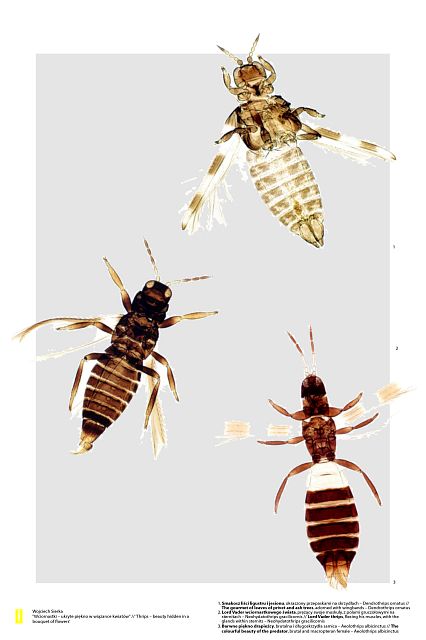
Description popularizing the research project
Has anyone seen thrips? Indeed you have to make some effort to notice them, and make even more to notice in them relatives of butterflies, grasshoppers and dragonflies. These tiny insects which do not exceed 2 mm length hide from our eyes in thickets, among leaves and flowers. So has anybody seen them? Pot flowers lovers surely has. Aficionados and connoisseurs of orchids know them too, but have little if any sympathy for them as they consider thrips to be troublesome pests. It is so because most thrips feed on plants juices.
For most people the problem of thrips simply does not exist. Which lady would examine meticulously a bouquet of flowers with a magnifying glass? Even sweeping fallen petals is not a good moment to observe the creatures running away in panic. Meanwhile the tiny insects live in a nearby meadow, a group of trees and in a forest. In Upper Silesia they prefer groups of trees or bushes which are separated from forests by stretches of fields. They are also present in the undergrowth of forests. There you can find the rarest species of them. Moreover they are present in dry sunny meadows as well.
Silesian Upland is inhabited by 84 species of thrips what makes almost half of all thripid species in Poland. It is hard to like them as they hide themselves behind difficult Latin names, but in spite of this we should appreciate them because they contribute to species and genetic abundance of our region. After all each life is beautiful and you just have to look at from a different point of view.
Abstract
Thrips are diminutive insects, individually so small that they easily pass unnoticed. They are widespread throughout the world, with a preponderance of tropical species, many temperate ones, and even a few species extending to arctic regions. Their habitats include forests, grasslands, scrub, desert, most cultivated crops and gardens. They are phytophagous and carnivorous species and gall-makers as well.
Most laymen perceive individual thrips as a dark or pale speck. The order Thysanoptera comprises of an array of beautiful and diverse creatures, either brightly coloured or sombrely shaded, often intricately sculptured, and occasionally of bizarre shapes and proportions. But the most striking feature, common to all of species, is their delicately fringed wings which give the order its scientific name, Thysanoptera, derived from two Greek words meaning a fringe, and a wing. Their common name, thrips, is also derived from the Greek, meaning a "wood louse". Other names are thunderflies or stormflies, names attributed to the frequent appearance of some species in stormy weather.
The investigations on Thysanoptera fauna of Jaworznickie Hills were conducted from 1998 to 2006 ont 17 sites in 7 selected plant associations. 27,003 specimens of thrips were collected and they represented 84 species. The richest thrips fauna was found in scrub (Rhamno - Prunetea) and in xerothermic grasslands (Festuco - Brometea). In mixed forest and coniferous forests (Querco - Fagetea, Vaccinio - Piceetea) a few species were closely connected with living trees and with litter and rotting wood, for example Oxythrips ajugae or Hoplandrothrips williamsianus.
The Thysanoptera communities inhabiting typical plant associations in the region were characterized through determining their species composition, abundance and dominance structure. Moreover, Thysanoptera species characteristic for the fauna of each association were distinguished.
Due to the similarity of the species composition of the associations under discussion makes it possible to distinguish 3 partly overlapping group. The first group contained communities of dry areas: field thickets, forest edge communities and xerothermic grasslands. The second group contained communities meadows. The third group consisted of forest communities.

